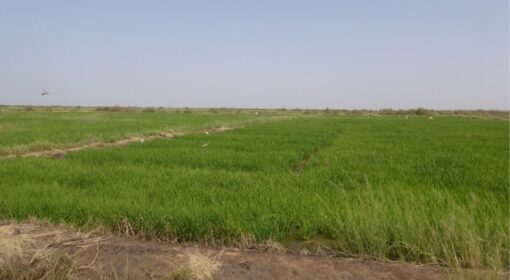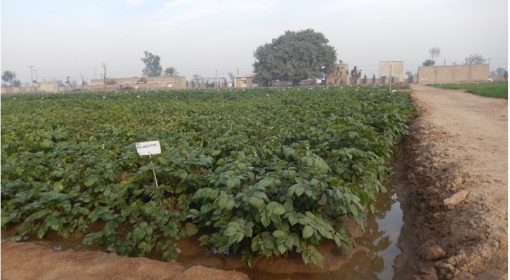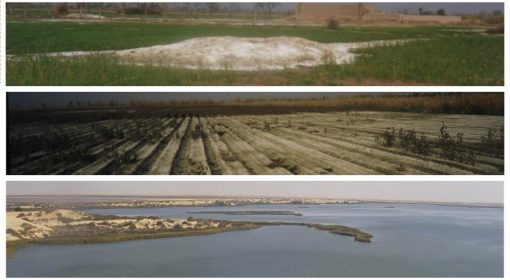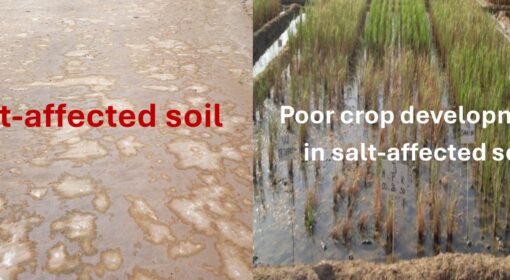by Clara Nieuwenhuyse, Ali Ibrahim, Eric Kabore
Salinisation is the increase in concentration of salts in the soil. Salinisation can happen via natural processes, such as seawater intrusion, flooding, specific geological features, high evaporation rates and dry climates, or human activities such as the overuse of fertilizers, irrigation with salt-loaded water and poor drainage systems. In irrigated areas, large-scale soil salinization is mainly caused by irrigation with saline water sources or from shallow saline water tables.
In Senegal, the main value chains affected by salinization are rice, sorghum, and millet production, as well as vegetable gardening. It is estimated that 1.7 million hectares are affected, representing 45% of arable lands over the country. The impact of soil salinization on the local population is multiple: damaged arable lands are abandoned, and an increased shortage of suitable arable land happens as the population increases. The migration of younger populations towards urban centres for new economic opportunities is also an important consequence.
As soil salinization is influenced by a diverse range of factors, one can wonder where to start. The following blog provides an overview of important points to consider for soil management strategies to counter salinity.
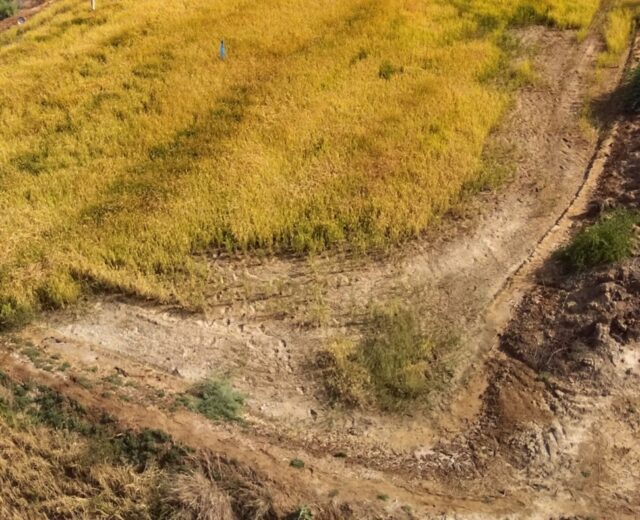
Crop and soil management are key in the fight for soil salinization mitigation. Adding soil organic matter improves the structure of the soil and flushes salts from it. A higher content in organic matter leads to an improved water-holding capacity of the soil, which decreases the concentration of soluble salts instead of accumulating them in the root zone. Organic matter also contributes to the formation of soil aggregates, creating pores that allow for air and water movements in the soil. As a result, excessive salts are taken away from the root zone and leached deeper in the soil profile.
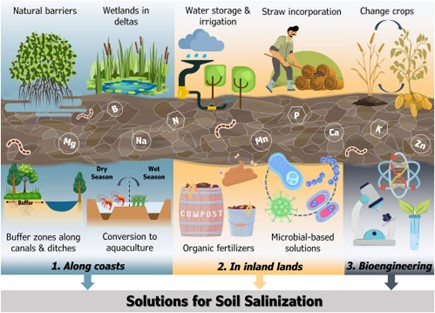
- The incorporation of straw can be a significant way to increase the soil organic matter content. Straw incorporation techniques encompass ploughing, disking, or harrowing. Mulching or conservation tillage practices that leave the straw on the soil surface are also recommended.
- Soil cover or mulching plays an important role in addressing soil salinity by protecting the soil surface from direct evaporation and it reduces salt accumulation close to root zone. However, one must be aware that straw quality and quantity influence the effectiveness of this mitigation measure. Aside from increasing methane emissions, slow straw decomposition in fields or excessive residues hinders the crop germination and development (Ma et al., 2008; Su et al., 2014).
- To counter adverse effects straw incorporation could bring to the crops, the use of organic fertilizers allows for building soil organic carbon levels in a similar mitigation strategy. Organic fertilizers are derived from natural sources, such as animal manure, compost or cover crops. The carbon source offered by organic matter to the soil also stimulates the activity of microorganisms that decompose organic materials. As a result, essential nutrients for plant growth are released gradually, supporting nutrient cycling and availability in the soil. Efficient nutrient management supports balanced soil ecosystems and prevents the accumulation of salts.
- In a study conducted by Sudratt & Faiyue (2023), rice husk biochar amendment had a positive effect on the growth and yield of rice plants growing in soil subject to saltwater intrusion at the seedling stage. Biochar mitigated the adverse effects of saline water intrusion by absorbing Na+ ions in the soil, reducing Na+ uptake to the shoot and increasing the K+/Na+ ratio (Sudratt & Faiyue, 2023).
Halotolerant microorganisms can enhance the plant ability to cope with salinity stress. Those organisms support plant growth, stress tolerance and nutrient absorption (Orhan, 2021), suggesting that microbial inoculations could bring promising results to help plant growth in salinized environments. Accurate and suitable bioinoculants must be selected along with the crop variety. However, the introduction of microbial inoculants into the crops ecosystems raises risks of endangering indigenous communities (Tarolli et al., 2024).
Crop rotations with an alternation of salt-tolerant varieties with salt-sensitive ones can disrupt the salt accumulation cycle, which ultimately alleviates plant stress (Cuevas, 2019). Salt-sensitive species would be grown in the rainy season, while tolerant varieties can be grown in the dry season. Allowing a fallow period at the beginning of the rain season allows rain to wash the salt and lower the salinity levels. Cover crops incorporated in crop rotations is another promising practice, which can be used as mulch for the main crop.
Gypsum (CaSO4.2H2O) is a soil amendment that regulates the exchange of sodium ions (Na+) for calcium (Ca2+) on the clay surfaces. When incorporated to the soil, gypsum also promotes plant growth by providing sulfur (S), which stimulates the production of organic compounds (phytohormones, amino acids, osmoprotectants, etc.) supporting the plant response to salinity stress. Gypsum origins from sedimentary rocks with a high sulfur and calcium content. It can also be produced as a by-product in the industrial production of sulfuric and phosphoric acids. A general guideline for the application of gypsum for soil salinity mitigation is that 3.4 t/ha are needed to replace 1 cmolc of exchangeable Na/kg dry soil in a layer of 30cm (Weil & Brady, 2017).
This blog is part of a series developed in the context of the ISSM4RICE project (see link: Tackling soil salinity in rice-based systems – TheWaterChannel)
Read more:
Tackling soil salinity in rice-based systems – TheWaterChannel
Link to salinity management fascicules (in French): Salinity management in ricefields manuals | MetaMeta – The Difference in Water, Land and People
References:
Ma, J., Xu, H., Yagi, K., & Cai, Z. (2008). Methane emission from paddy soils as affected by wheat straw returning mode. Plant and Soil, 313, 167-174.
Orhan F. (2021). Potential of halophilic/halotolerant bacteria in enhancing plant growth under salt stress. Curr. Microbiol. 78, 3708–3719. doi: 10.1007/s00284-021-02637-z
Su, W., Lu, J., Wang, W., Li, X., Ren, T., & Cong, R. (2014). Influence of rice straw mulching on seed yield and nitrogen use efficiency of winter oilseed rape (Brassica napus L.) in intensive rice–oilseed rape cropping system. Field Crops Research, 159, 53-61.
Sudratt N. and Faiyue B. (2023). Biochar mitigates combined effects of soil salinity and saltwater intrusion on rice (Oryza sativa L.) by regulating ion uptake. Agronomy 2023, 13, 815. https://doi.org/ 10.3390/agronomy13030815
Tarolli P., Luo J., Park E., Barcaccia G., and Masin R. (2024). Soil salinization in agriculture: Mitigation and adaptation strategies combining nature-based solutions and bioengineering. iScience 27(108830), 9p. https://doi.org/10.1016/j.isci.2024.108830
Weil R.R. and Brady N.C. (2017). The nature and properties of soils. Fifteenth edition. Library of Congress Cataloging-in-Publication Data. ISBN: 978-0133254488.
